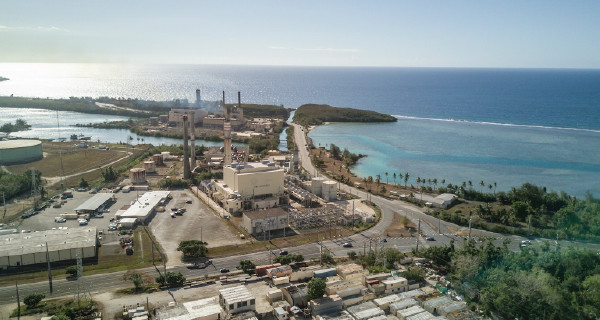Chelan County PUD unveils new hydropower contract with Puget Sound Energy
May 4, 2021
by Paul Ciampoli
APPA News Director
May 4, 2021
Washington State’s Chelan County Public Utility District and Puget Sound Energy (PSE) on April 27 unveiled a new contract for hydropower from two PUD hydro projects on the Columbia River.
The five-year contract supplies PSE with 5% of the output from the PUD’s Rock Island and Rocky Reach hydropower projects from 2022 through 2026.
The contract complements an existing contract between the two utilities, while generating revenue for the PUD to provide continued rate stability for its customers, Chelan said.
PSE secured the contract following a competitive bidding process in the first quarter of 2021.
Chelan noted that the contract will bolster PSE’s supply of carbon-free energy, in line with the goal of becoming a “Beyond Net Zero Carbon” energy company by 2045, while also supporting Washington state’s Clean Energy Transformation Act goals.
Chelan PUD in March said that it is evaluating its strategies to sell carbon-free, surplus power as long-term energy output contracts expire over the next decade.
Chelan PUD General Manager Steve Wright on March 15 presented a plan that would support more economic growth locally, while also allowing the PUD to capitalize on favorable market conditions, the PUD said.
Guam Power Authority bolsters resilience and charts path to 50% renewables
May 3, 2021
by APPA News
May 3, 2021
In honor of Asian American and Pacific Islander (API) Heritage Month – commemorated each May – the American Public Power Association’s Public Power Current newsletter is proudly spotlighting the leadership roles our API colleagues have at public power utilities across the United States and at our U.S. territories in the Western Pacific. We kickoff our coverage by sharing updates from Guam, “a beautiful, tropical island with an equable climate and melting-pot of hospitable people,” according to Guam Power Authority General Manager John M. Benavente, P.E. said Guam “is a modern and culturally diverse community with practically all the amenities of living, similar to elsewhere in the U.S.” He encourages you to visit Guam and “enjoy the paradise of this island territory of the U.S.”
Our next feature article will highlight API public power leaders here on the mainland representing the many diverse Asian-Pacific Islander cultures from China to the Philippines, and India to Vietnam.
Guam Power Authority (GPA)
Håfa Adai. Guam is an unincorporated U.S. territory in the Western Pacific; for reference, it is located 3,950 miles west of Hawaii and 5,974 miles west of California. A progressive Pacific island community – and a strategically important link between the U.S. and Asia – there is a critical bond between energy and Guam’s economic advancement.

GPA supplies monopolistic electricity services, including to all U.S. military bases (the Navy is Guam’s largest customer), various governmental components, and a vibrant shopping and hotel plus tourism industry.
GPA serves 170,000 people (or 52,000 customers) with a 2019 peak demand of 254 megawatts (MW). The island community has evolved significantly from pre-WWII wood, lime mortar, and stone houses with thatched or Spanish tile roofs. Following typhoons Karen (1962) and Pamela (1976), today’s businesses and homes are made of reinforced concrete with typhoon shutters.
GPA has similarly undertaken significant system hardening initiatives: power plants are constructed with concrete or prefabricated structures to withstand 180 mph winds; vital power transmission lines are underground, with 60% of system load served through underground infrastructure; over 87% of GPA’s wood poles have been replaced with mono-tube, U.S. Navy-built octagonal concrete poles, and round, industry-spun concrete poles that can also withstand 180 mph wind speeds; and GPA continues its village underground hybrid system to place secondary lines (over 20%) underground too.
These investments have paid off. In September 2018, Category 2 Typhoon Mangkhut (106 mph winds) passed just north of Guam. Although 6% of GPA’s customers kept power during the storm, 51% of customers were restored by the next day – and 90% by the fourth day of restoration. Additionally, over 250 stand-by generators – supplied and maintained by GPA – ensured that 99% of all customers had uninterrupted water service during the storm.

GPA employs 450 people and owns $955 million in assets, including 29 substations and 1,800 miles of transmission and distribution lines. It is governed by a 5-member Consolidated Commission on Utilities board, while the Guam Public Utilities Commission sets GPA’s rates and holds oversight authority over all large GPA contracts impacting rates and charges.
GPA supports Guam’s economy with both conventional fuel oil and renewable energy – currently, GPA has 25.3 MW of renewable capacity with an additional 160 MW of solar photovoltaic and 150 MWH of energy storage – which will help achieve a 25% Renewable Portfolio Standard mandate by 2024.
Benavente notes that GPA’s energy had been generated by fossil fuels for five decades, which made Guam vulnerable to and at the mercy of geopolitical fuel oil challenges. Fuel oil purchases total more than half of GPA’s budget. “It is a significant economic drain on Guam’s economy,” he said. “By converting fuel oil purchases to alternative energy purchases such as photovoltaics, Guam is converting oil to jobs, while at the same time reducing its carbon footprint and impact on the planet.”

GPA has signed contracts for the construction and operation of a 198 MW combined cycle plant with a thermal efficiency of 51% that is designed to be the cornerstone of GPA’s fleet.
“The plant will allow us to hedge against fluctuating fuel oil prices because over time we will continue to reduce the volume of fuel oil we use by substituting with photovoltaic energy sources. It will work well with renewables, and, in fact, will be the backup to renewable energy to ensure continuous power to the island, in the event of non-solar days and natural disasters.”
In addition, he said, “All renewables must have adequate storage systems for full capacity load shifting capability. All contracts will comprise a power purchase agreement for 25 years or more. The majority of this capacity will be utility-scale renewables, but the program would also include rooftop solar and small energy farms.”
“The [new Dededo Ukudu Combined Cycle Power Plant], coupled with renewables, will allow GPA to achieve 50% renewables, most likely before the end of this decade,” he added.

GPA has also been investing in Advanced Metering Infrastructure systems, upgrading its billing systems to accommodate 2,100 net metering customers, and has an ongoing Demand Side Management program to assist customers in lowering their total energy cost.
To attract and retain high quality staff Benavente explained that GPA “adopted a pay-for-performance employee pay structure, which rewards its employees and assures a competitive pay structure and benefits today, and into the future.” GPA subsequently became a premier employer of choice on Guam – always drawing significant interest and numerous applicants for positions. GPA also runs apprenticeship and other training programs.
GPA embraces the criticality in operating an island grid and working with local communities; geographic isolation presents unique challenges to disaster readiness and recovery for island communities. “From as far away as the U.S. Virgin Islands to the nearer Commonwealth of the Northern Mariana Islands (CNMI)-Saipan, GPA is committed to, and has provided, mutual aid assistance for recovery and restoration following devastation caused by natural disasters.” In 2019, GPA received APPA’s Mutual Aid Commendation award for having answered the call for help and assisting the devastated CNMI-Saipan community restore power and helping to rebuild an entire island economy.
GPA has also received a Smart Energy Provider designation from APPA, and was recognized as the first electric distribution utility to operate business critical functions on the Environmental Systems Research Institute’s Utility Network Data through tapping drones to digitally map power lines, poles and other hardware and help GPA with maintenance forecasting, deployment of manpower and equipment.
Within the next few years, GPA will have significantly shifted the paradigm in energy supply for customers by providing reliable energy at an affordable and stable cost and Benavente envisions that GPA “will begin the journey forward to fully underground the electrical power system within the next few decades, so that Guam becomes an even more sustainable island, less vulnerable to economic and natural disasters.”
Benavente is understandably very proud of the transformation that GPA has gone through. “Over the past 53 years, GPA, through its founding employees and today’s team of professionals and staff, has striven for sustainability and an ever-improving quality of life for our extremely remote island. Today, we see light at the end of the tunnel and this truly is exciting and commendable.”

We are pleased to introduce our readers to a few of GPA’s employees – some of whom you may have met at APPA events – and to celebrate their contributions to public power and our local communities during Asian American and Pacific Islander Heritage Month.
 John M. Benavente, P.E., General Manager
John M. Benavente, P.E., General Manager
An Asian/Pacific Islander himself, from Guam, he climbed through the GPA ranks and has held the leadership position for over 25 years. He has expertise spanning over four decades of technical, engineering, operations and executive leadership in the power and water utility-related fields across both the government and private sectors. Benavente is a licensed Professional Mechanical Engineer in Guam. He holds a Master of Science in Engineering Management from the University of Missouri (Rolla) and a Bachelor of Science in Mechanical Engineering from the University of Dayton in Ohio.
Benavente’s current efforts include addressing GPA’s core value strategies of providing a sustainable energy supply for Guam, hardening GPA’s grid infrastructure, workforce planning and management, building GPA’s new, combined cycle 198 MW Ukudu power plant, and achieving a 50% renewable energy supply for Guam by 2030.
He is particularly proud that “GPA has consistently placed highly, in the top three safety categories for its utility workforce safety performance. Safety is of primary importance to myself and my entire team, and GPA provides significant resources and training to ensure safety first, across all areas of the power utility. It will continue to strive to perform and be ranked among the safest electrical power utilities and do everything it can to send all workers safely home to their families each and every night.”
He is also proud to be part of GPA’s 53-year history, “having contributed to bringing GPA to where it is today, so that Guam becomes an even more sustainable island, less vulnerable to economic, natural and other disasters.”
“There is still much to do, but the good news is much will be achieved over the next several years, which will improve reliability substantially and bring energy costs to the affordable range for all customers,” he added.
Benavente has served on APPA’s Board of Directors since 2016, representing Region 10 that is comprised of American Samoa, Guam, the Marianas Islands, Puerto Rico and the U.S. Virgin Islands.
 Melinda C. Mafnas, P.E.
Melinda C. Mafnas, P.E.
The opportunity to learn all aspects of the power system drew Mrs. Melinda C. Mafnas to public power.
A Chamorro woman and a home-grown talent, she received her Bachelor of Science degree in electrical engineering from the University of Hawaii at Manoa and is a registered Professional Electrical Engineer in Guam with 30 years of experience working at GPA.
Mafnas joined GPA in 1991 as an engineer. “I was not limited to design work. Once projects were completed and operational, I continued to work with generation, substation, and line electricians to enhance my knowledge and grow in my profession.”
She rose through the ranks, as the Supervisor of Distribution Engineering, then Supervisor of the Substation/Transmission Engineering section directing both medium and high voltage projects, and next as GPA’s Manager of Engineering responsible for the overall administration of engineering-related work.
“With this continued growth, I eventually became the Assistant General Manager of Operations in charge of power generation, transmission, distribution, and dispatching” she said.
Mafnas is the first woman in that role and now manages approximately 300 employees and a multi-million-dollar annual budget.
She said two things stand out to her: “Watching the growth and development of apprentices that become journeymen and grow into leaders. Equally amazing is knowing that everyday life on Guam is made possible by the service the Guam Power Authority delivers. I find joy and accomplishment helping customers. Every person that turns on a light switch and every child doing research online or attending virtual classes can do so because of GPA.”
When asked what she enjoys most about working for public power, Mafnas proclaimed, “I love my job!”
While operating an island power system is complicated and challenging by its very nature, she said that “Overcoming these challenges and providing stable, reliable power inspires me to do more. Knowing I am making a difference and a positive impact in the community is a great feeling. Power is an essential service and extending lines, troubleshooting issues, lighting up roadways, meeting the demand for power every hour of every day is rewarding. Students can attend classes, water is flowing to homes and businesses, roadways and villages are safe because of street lighting and security cameras, families anywhere in the world can communicate with loved ones on Guam through Face Time and virtual meetings because of the power GPA delivers to them.”
She said the hospitality of the people sets Guam apart from other places. “Guam is beautiful. The Guam Power Authority provides a vital service to the island and as GPA thrives, so does Guam.”
 John J. Cruz Jr., P.E., CEA, CEM, MBA
John J. Cruz Jr., P.E., CEA, CEM, MBA
Guam Power Authority’s Assistant General Manager for Engineering and Technical Services, John Cruz oversees several areas currently leading GPA’s transformation to a highly diversified, resilient modern power grid as well as driving its comprehensive digital transformation.
He holds a Bachelor of Science degree in electrical engineering, a Bachelor of Arts degree in mathematics, and a minor in business, from Gonzaga University in Spokane, Washington. He went on to earn a Master of Business Administration from the University of Phoenix.
Cruz has over 30 years of electric utility experience across multiple disciplines.
He began his career in 1982, working as a summer intern for GPA’s Engineering Manager. “In 1991, I was on a one-year leave of absence from Hughes Aircraft Company/Radar Systems Group to fulfill a request for assistance from my parents.” However, fate intervened, and he met his future wife at GPA and decided to stay. He accepted a job with GPA soon after returning to Guam.
Cruz said there were numerous, interesting challenges at GPA when he arrived. “I felt I could help solve or find solutions for some of those. Today, there are still challenges to overcome, and they are very exciting. Having joined GPA from another industry, I brought a different/external perspective on analyzing and understanding issues and the processes. As a multidiscipline systems engineer, I valued looking at things from different angles. I wanted to make a difference for the utility and in my community.”
Cruz and his teams provided the seminal ideas for, and executed, several of GPA’s key contracts and planning undertakings – including the acquisition of nearly $40 million of federal grants, the contracting for over 185 MW of renewable energy, and GPA’s Smart Grid Program.
“We have so many complex and difficult challenges and often have to span several disciplines to get the job done. Opportunities for great learning experiences are everywhere.
GPA is transforming across so many fronts with renewable energy, battery energy storage systems, smart grid, new flexible generation, information/operations technology, customer-facing digital applications, and more. These are exciting times. We get to do this through the lens of public service, making the ‘Power to Serve’ motto of GPA a reality.”
Cruz said that mentoring and staff development have been particularly meaningful for him. “Providing [staff] with great opportunities to grow in the engineering and technical profession. Many of the earliest employees I supervised have left Guam and GPA for opportunities on the U.S. mainland – working for CAISO, SEL, B&V, LEIDOS, and other firms. I am proud these staff attracted great offers and now work for renown mainland firms and instantly added value at the highest levels.”
Cruz notes that Guam is a unique American subculture. While also enjoying American sports and entertainment, “we are a unique society with deep, 4000-year-old roots, including 300 years as a Spanish colony and 123 years as an American territory” so Asian and Spanish cultural influences still run strong.
“We are a mixture of influences, a resilient people, and we are survivors. Our ancestors braved thousands of miles of open ocean, arriving to claim a place of their own. That spirit and determination still fuels us.”
 Jennifer G. Sablan, P.E., CEA, CEM
Jennifer G. Sablan, P.E., CEA, CEM
This pride in the resiliency of Guam’s people continues with Jennifer Sablan, a licensed Professional Mechanical Engineer in Guam. “People who live here are capable, resourceful and supportive. We are very resilient, especially during challenging times experiencing and enduring natural disasters. In the hardest of times, our strongly rooted familial values extend toward others and you just know that you are not alone and can make it through together,” she said.
Sablan joined GPA in 1995 as an Engineer I in the Generation Division, quickly engaged in the division’s processes and overall operations, and rose through the ranks.
She was appointed GPA’s manager of the Strategic Planning and Operations Research Division in 2017. She has 26 years of electric utility experience spanning technical, engineering, generation, operations and management.
Sablan holds a Bachelor of Science in Mechanical Engineering from Marquette University in Wisconsin and is a Certified Energy Auditor and Certified Energy Manager with the Association of Energy Engineers.
While in college her studies focused on power plants and Sablan intended to return to Guam. Working for GPA “seemed like the natural choice. Over the years I’ve seen challenges and progress within GPA and the passion from others who were leaders and/or came before me to provide safe, reliable and affordable electricity for the island.” She said this influenced her commitment to GPA as her career job.
In 2005, Sablan was appointed the project lead for GPA’s developing renewable energy acquisition program and integrated resource planning.
“Being part of new programs and projects that have a direct impact on our island community keeps me going,” she said. “It takes creativity and ingenuity to support some of the projects we’ve implemented over these past years in regards to funding, technical support and execution, which has helped to develop our island’s utility. It is awesome to look back at the discussions, planning and celebrations of these successes. It is also a great learning experience to bounce back from any shortcomings. I’ve been able to work with some great minds, continue my education especially on developing technologies, and meet a lot of people through various networking, which all support my work.”
She led GPA’s acquisition for its first utility-scale renewable energy contracts for a solar photovoltaic facility totaling over 25 megawatts. She has and continues to support additional utility-scale renewable energy contracts, which total over 120 megawatts of installed solar photovoltaic capacity.
Under her management, GPA’s first utility-scale Battery Energy Storage Systems project was commissioned in March 2021. It supports intermittent renewable energy, improves system reliability, and reduces costs for GPA’s ratepayers.
Sablan is focused on building GPA’s newest, combined cycle 198-megawatt baseload Dededo-Ukudu power plant, expected to come on-line in 2023, and which will further support additional renewables, replace aging units, address compliance requirements and improve system reliability.
She is particularly proud to “provide support in developing and executing programs and projects to contribute to GPA improving its services. GPA is moving forward, and I feel proud to have contributed to its progress and successes.”
New Vermont law offers flexible ratemaking structure for public power utilities
April 30, 2021
by Paul Ciampoli
APPA News Director
April 30, 2021
Vermont Gov. Phil Scott, a Republican, recently signed a bill into law that provides cooperative and community-owned public power utilities with the ability to make minor adjustments to electric rates and provide customers with new, innovative services, the Vermont Public Power Supply Authority (VPPSA) reported on April 30.
The legislation, S.60, which was sponsored by Vermont Sen. Ann Cummings, a Democrat, is the result of collaboration among electric utilities, state utility regulators, and Vermont legislators, VPPSA noted.
Prior to the passage of S.60, all electric utility rate adjustments and pilot programs were subject to formal reviews by state utility regulators. “Often lengthy and expensive, this review process also presents a hurdle to utility innovation,” VPPSA said in a news release.
The new law gives public power utilities the authority to implement rate changes up to 2% each year without undergoing the traditional reviews. It also allows utilities to pilot new services that advance Vermont’s climate requirements without being subject to a formal tariff review.
Utility regulators will maintain oversight under the new flexible ratemaking structure. Utilities must provide written notice to the Vermont Department of Public Service and Public Utility Commission 45 days prior to implementing a new rate or pilot offering.
The rate or pilot will only proceed if regulators do not raise an objection. A full, traditional review of utility rates will be triggered for individual rate increases over 2% or after a utility’s cumulative rate increases reach 10% since the last state review or if a decade has passed since the last state review.
Regulators also have the authority to implement the full review process any time an objection is raised against a utility proposal, VPPSA said.
The law goes into effect July 1, 2021.
VPPSA provides municipal electric utility members with a wide range of services and solutions, including regulatory assistance, financial planning, and power supply.
VPPSA members include Barton Village, Village of Enosburg Falls, Hardwick Electric Department, Village of Jacksonville Electric Company, Village of Johnson Electric Department, Ludlow Electric Light Department, Lyndonville Electric Department, Morrisville Water & Light Department, Town of Northfield Electric Department, Village of Orleans, and Swanton Village Electric Department.
SMUD board of directors approves 2030 zero carbon plan
April 30, 2021
by Paul Ciampoli
APPA News Director
April 30, 2021
The Board of Directors for California public power utility SMUD on April 28 approved a 2030 zero carbon plan for the utility.
The action comes after the board adopted a climate emergency declaration in July 2020 and asked staff to develop a plan to expedite carbon reductions due to the growing threats of climate change, SMUD noted.
SMUD said that over the past eight months, its staff has worked with customers and a variety of stakeholders to develop a plan that relies on:
- Proven renewable technologies like wind, solar, hydroelectric, geothermal and biomass energy, and customer demand response. The plan triples renewable resources and battery storage and expands customer-owned resources such as rooftop solar and battery storage. Today, these resources help SMUD deliver power that is about 50 percent carbon free;
- Exploring and pursuing new and emerging technologies like biofuels, thermal/battery hybrid, pumped hydroelectric storage, carbon capture and storage, power-to-gas, hydrogen and methane, long-duration batteries and compressed air storage;
- New partnerships and business models to pursue emerging technology such as virtual power plants, vehicle-to-grid projects and more to leverage customers’ investments in clean energy to offset the need for energy from conventional gas power plants;
- Aggressively support electrifying buildings and vehicles, because these are the two largest carbon emitting sectors in the state; and
- Retiring, repurposing or repowering SMUD’s natural gas power plants, including the retirement of McClellan and Campbells gas-fired plants by 2025. The 2030 Zero Carbon Plan includes a road map for retiring or refueling SMUD’s remaining plants by 2030, and SMUD will complete a robust reliability study to finalize the schedule.
The plan provides 90 percent of SMUD’s power from renewable sources, including up to an additional:
- 1,500 megawatts (MW) new local utility solar
- 700 to 1,100 MW local batteries
- 300 to 500 MW wind
- 100 to 220 MW geothermal
- 100 MW regional solar
SMUD said that customers will play an important role in the region’s path to zero carbon. Over the next nine years, forecasts show customers will invest extensively in carbon-free energy resources, including 500 to 750 MW of rooftop solar and 50 to 250 MW of customer-owned battery storage, it noted.
“To pay for new technologies and make them available to customers in an equitable manner, SMUD will pursue partnerships, investors and grant funding, while keeping rates below inflation,” it said in a news release.
Paul Lau, SMUD’s CEO and general manager, recently discussed the zero carbon plan in an episode of the American Public Power Association’s Public Power Now podcast.
New Jersey utility regulators approve certificates to support nuclear plants
April 29, 2021
by Paul Ciampoli
APPA News Director
April 29, 2021
The New Jersey Board of Public Utilities (NJBPU) on April 27 approved three-year zero emission certificates (ZECs) for the Hope Creek, Salem One and Salem Two nuclear power plants in the state.
The NJBPU said that the certificates ensure that the plants, which supply the state with over 90 percent of in-state generation and 37.5 percent of its overall in-state energy supply, will remain operational.
Operated by PSEG Nuclear, a subsidiary of investor-owned Public Service Enterprise Group, Salem is located along with Hope Creek Generating Station on a 740-acre site in Salem County, N.J.
PSEG owns 57% of Salem, while Exelon Corporation owns the remaining 43%. Hope Creek is entirely owned by PSEG.
The collection of funds to pay for the credits the NJBPU approved on April 27 will begin immediately and will amount to approximately $100 million in annual subsidies for each plant for three years, at the rate of $0.004 per kilowatt hour.
At the end of three years, the board will reevaluate the program and if more money is collected than needed, those funds will be returned to ratepayers, the NJBPU noted in a news release.
In addition, if the companies receive funding via other state or federal subsidies in the future, those funds will be reconciled against the ZECs and returned to ratepayers, it said.
The NJBPU in November 2019 approved a ZEC program and application process for nuclear power plants.
The creation of the ZEC program was a requirement of legislation signed by New Jersey Gov. Phil Murphy in May 2018. Murphy signed a bill (S-2313) that created a ZEC program to support nuclear generation in the state — the 2,468-MW Salem plant and the 1,240-MW Hope Creek facility.
The application process for the second three-year ZEC eligibility period opened in August 2020. In October 2020, the NJBPU received applications for the Hope Creek, Salem One, and Salem Two plants. NJBPU Staff evaluated the applications for eligibility and ranked the applications.
As part of the evaluation process, the Board published a redacted version of all applications on its website, held public meetings and an evidentiary hearing, opened a public comment period, and provided an independent market monitor and New Jersey Division of Rate Counsel access to confidential financial information in order to assess each application. The public also had access to a redacted analysis completed by Levitan, a consulting firm.
Prior to this, the NJBPU held a public stakeholder input process in July 2020 on the ZEC application form, which was revised from the version used in 2018 during the first three-year eligibility period.
CAISO launches initiative to explore market reforms tied to grid-scale storage growth
April 29, 2021
by Paul Ciampoli
APPA News Director
April 29, 2021
The California Independent System Operator (CAISO) on April 28 launched an initiative to explore market reforms in anticipation of a surge of grid-scale energy storage on its system in the next few years.
CAISO in a news release noted that it is projecting a four-fold increase in the amount of battery storage on its system from late last year to this summer.
At the end of 2020, the ISO had about 250 megawatts (MW) of storage resources — primarily 4-hour batteries — connected to the grid. It currently has about 500 MW on its system and expects to have a total of 2,000 MW by August 1. This rapid pace of growth is expected to continue in the years ahead, the grid operator said.
“Unlocking the full value of energy storage resources requires changes to the ISO market to better align price signals and cost recovery mechanisms with the reliability and operational needs of the grid,” CAISO said.
The ISO said it intends to leverage expertise from across the storage industry and to share its findings through such initiatives as the Global Power System Transformation Consortium that was formally launched in April with the U.S. Department of Energy and utilities.
CAISO publishes issue paper
CAISO on April 28 published an issue paper on possible energy storage enhancements, outlining the current challenges and seeking input on new market mechanisms to fully integrate storage and maximize its use on California’s electricity system.
The grid operator said that the issue paper effectively launches the energy storage enhancements stakeholder initiative process, which will invite feedback from all industry sectors, particularly the storage resource community, on the market redesigns and their effects.
Deadline to register for APPA national conference fast approaching as spots fill up
April 28, 2021
by Paul Ciampoli
APPA News Director
April 28, 2021
The deadline to register for the American Public Power Association’s 2021 National Conference is fast approaching, with available spots filling up quickly.
This year, the National Conference will be held in Orlando, Fla., from June 20-23, followed by a virtual event on July 13-14.
Participants can choose to register for the full conference (including both the in-person event and the virtual event), or just the virtual event.
Registration for the in-person event (full access) is limited to 700 attendees to accommodate social distancing measures. Early registrations are encouraged to ensure a spot. There is no cap on virtual meeting participation.
For the in-person conference, Admiral James Stavridis, USN (Ret.) on June 21 will share how two factors — a new emerging global security environment and the coronavirus — affect geopolitics for the U.S., China, Russia, Europe, and other areas.
Conference breakout sessions on June 21 will include current issues in federal transmission policy, what’s happening in Washington, D.C., and how small utilities navigate change.
The general session on June 21 is a CEO roundtable on resilience and response.
On June 22, breakout sessions include keeping up with climate policy in the Biden Administration, microgrids and creating value from data assets.
“APPA’s National Conference is a great way for members of the public power community to learn about the latest trends and developments in the electricity sector,” said Ursula Schryver, Vice President, Strategic Member Engagement and Education at APPA.
“Having an in-person event in Orlando also provides an excellent opportunity for public power officials at all levels of responsibility to network with their peers,” she added.
Schryver discussed the national conference in a recent APPA Public Power Now podcast.
All participants in the in-person event must agree to adhere to requirements outlined in the APPA Duty of Care Agreement.
Group discounts will be available for organizations that register five or more people, regardless of the format.
Register by May 31 to lock in savings for the in-person and virtual events. Additional details are available here.
Idaho Falls Power, with Idaho National Lab, tests small hydro’s black start capabilities
April 28, 2021
by Peter Maloney
APPA News
April 28, 2021
Idaho National Laboratory (INL), working with public power utility Idaho Falls Power, has completed a series of tests designed to assess how small hydropower plants can provide startup power during outages.
The city of Idaho Falls, Idaho, owns five, small run-of-river hydro plants on the Snake River that, combined, can provide enough power to meet about one-third of the city’s power needs.
After a December 2013 outage left 3,500 residents without power in subzero weather for hours, the public power utility began to explore options that would make the city’s power system more resilient in such an emergency.
Even though Idaho Falls has its own generating plants, they are all low head, low pressure hydro plants. “We assumed the plants would be able to start up on their own in an emergency, but assuming is not knowing,” Ben Jenkins, systems engineer at Idaho Falls Power, said.
In 2016, Idaho Falls and INL began investigating the ability of its generators to start up on their own, known as black start capability, and their ability to island or operate independently of the surrounding grid.
In December 2017, the utility tested its assumptions and found that as it started adding load to its generators, they would become unstable at about 30 or 35 percent of rated capacity. The test found the limits of the utility’s system. “There was plenty of water, but low head machines need the grid to keep them stable,” Jenkins said.
Idaho Falls Power began looking for ways to fix the problem and enlisted the aid of INL, which is based in Idaho Falls and is an Idaho Falls Power customer.
“The INL folks were looking at the larger picture, the larger grid, and we were looking at the local picture,” Jenkins said. “Our needs dovetailed nicely.”
For its part, INL tested the use of ultracapacitors, which can store and discharge large amounts of energy very quickly, to provide pseudo inertia to the generating plants.
The tests demonstrated that “small hydropower plants like Idaho Falls’, combined with integrated energy storage technologies, may prove to be as nimble as natural gas when it comes to load following,” Thomas Mosier, INL’s energy systems group lead, said in a statement.
Idaho Falls Power tested two operational changes. Working with equipment provider American Governor, the utility tested variations in the gates and blade pitch of its hydro plants to find the most efficient and stable configurations.
Idaho Falls Power also tried bringing multiple plants online simultaneously, running nine tests, each with different combinations of operating parameters. “In effect, we were simulating a large plant,” Jenkins said.
“The one big thing we learned, we didn’t even know we were looking for,” Jenkins said. “If all the load is on one plant, it is unstable, but if you bring them all up simultaneously, they overperformed. We got more out of the combined plants than out of each plant individually.”
“We were pleasantly surprised; operational control can make a huge difference,” Jenkins said. If Idaho Fall Power lost power from the grid, it could implement the operational changes and restart its generators and gradually add load and operate in islanded mode.
Operational changes can also be implemented with minimal costs.
The test results have also prompted Idaho Falls Power to look at another form of energy storage, batteries. They can provide “multiple values,” Jenkins said, citing their ability to provide services such as peak shaving in addition to providing generation stability.
Idaho Falls Power is in conversation with INL about batteries, Jenkins said, and, with battery prices coming down, they could become more attractive. “What was financially unattainable two years ago is now becoming viable,” he said. “There could be value we can look at.”
With the testing portion of the collaboration concluding, there is going to be a lot of evaluation of the next few months, Jenkins said. The data collected in the tests will be fed into INL’s digital real time simulators, which can offer insight into how grids will act and react under different conditions. Then, two reports will likely be generated, one simple and another more detailed.
“We are very happy with what we learned from this, and if the information ca be used by other small utilities, all the better,” Jenkins said. “We feel we are part of a bigger involvement. It helps Idaho Falls, but it could have a much broader impact on the national grid.”
Steve Wright to step down as GM of Chelan PUD
April 28, 2021
by Paul Ciampoli
APPA News Director
April 28, 2021
Steve Wright plans to step down from his position as general manager of Washington State’s Chelan County PUD, the PUD said on April 27.
“After eight years it’s time for me to move on and give someone else a chance to run this great utility. My contract with the PUD to serve as the General Manager runs through the end of this year,” he said in a statement. “I have informed the board that I do not intend to serve as the General Manager beyond that.”
He said the primary reason “is simply that it’s been long enough. I’ve spent 40 years in the industry, 20 years in leadership. I want the opportunity to try something new.”
Chelan’s board “has known of my intentions and has had time to make plans. I am announcing early so the board has plenty of time to conduct a full search. Hopefully, there will be time for overlap with a new general manager before I leave,” he said.
Wright currently serves as a member of the American Public Power Association’s Board of Directors and the board’s executive committee.
Experts see cost of wind power declining by nearly 50% by 2050
April 27, 2021
by Peter Maloney
APPA News
April 27, 2021
The cost of wind energy is expected to decline by as much as 35 percent by 2035 and by almost 50 percent by 2050, according to a survey conducted by Lawrence Berkeley National Laboratory.
The experts responding to the Berkeley Lab survey estimated median reductions in the levelized cost of energy (LCOE) for wind power of 17 to 35 percent by 2035 and of 37 to 49 percent by 2050.
Participants in the survey focused on five core LCOE inputs: capital costs, operating expenditures, energy output (capacity factor), project life in years, and financing costs (after-tax, nominal weighted-average cost of capital).
The reductions are driven by larger and more efficient wind turbines, lower capital and operating costs, and other advancements, according to the survey findings, which were published in the journal Nature Energy.
The study summarized a global survey of 140 wind experts who considered three types of wind applications: onshore (land-based) wind, fixed-bottom offshore wind, and floating offshore wind. The anticipated future costs for all three types of wind energy were half of what experts predicted in a similar study Berkeley Lab conducted in 2015.
“Wind has experienced accelerated cost reductions in recent years, both onshore and offshore, making previous cost forecasts obsolete,” Ryan Wiser, senior scientist at Berkeley Lab, said in a statement. “The energy sector needs a current assessment.”
The Berkeley Lab survey complements other cost evaluation methods and sheds light on the uncertainties in those estimates, Wiser said. For instance, cost reductions could be relatively modest, as reflected in the lower end of the estimates, but there is also “substantial room for improvement” with reductions even greater than experts predict. There is a 10 percent chance that cost reductions will be in the 38 to 53 percent range by 2035 and in the 54 to 64 percent range by 2050, the study found.
The experts surveyed also anticipate greater absolute reductions – and more uncertainty – in the LCOE for offshore wind compared with onshore wind but see a narrowing gap between fixed-bottom and floating offshore wind.
The survey also revealed that one of the key drivers in cost reductions is improvements in wind turbine sizes. The average capacity ratings of onshore wind turbines are expected to rise to 5.5 megawatts [MW] in 2035 from 2.5 MW in 2019 as rotor diameters and hub heights also increase.
The experts said they expect offshore wind turbines to get even larger, rising to 17 MW on average in 2035, from 6 MW in 2019.
The experts also said they see floating offshore wind gaining market share, growing from its current pre-commercial state to capturing up to 25% of new offshore wind projects by 2035.
“All else being equal, these trends will enable wind to play a larger role in global energy supply than previously thought while facilitating energy-sector decarbonization,” Joachim Seel with Berkeley Lab and a co-author of the study, said in a statement.
Berkeley Lab took the lead in the study, which was conducted under the auspices of the IEA Wind Technology Collaboration Programme with funding from the U.S. Department of Energy’s Office of Energy Efficiency and Renewable Energy.
